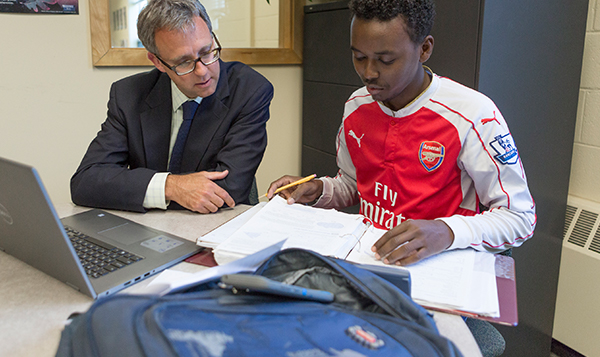Financial Wellness Overview
April is #FinancialLiteracyMonth. Financial wellness is a state of being in which you can meet current and future financial obligations, feel secure with your finances and make choices that let you enjoy life. We hope to help you on that journey. Please share with us in the comments what you are doing to improve your financial wellness.
We all know how beneficial a healthy diet, meditation, and movement can be for our physical and mental wellbeing – but what about staying fiscally fit? Think of budgeting, building a robust savings, and planning for the future as your financial fitness routine. Keep your eye on our page each week as we post tips and tricks for staying fiscally fit.
Creating a financial plan can help you achieve your goals. To get started, follow these four easy steps: ✅ Create an emergency fund with a minimum of $1,000 for unplanned expenses such as a major illness, property damage, job loss, etc. ✅ Make a list of priorities. Experts suggest starting with paying off debt, then building 3 to 6 months of expenses in an emergency fund, and finally, beginning longer-term saving and investing. ✅ Create a budget to help stay on track and meet your goals. ✅ Open both a checking and a savings account or multiple savings account. Banking your money is the safest option.
Budgeting
What is a budget and why is it so important? A budget is the amount of money that is available for, required for, or assigned to a particular purpose. In this case, your budget is determined by income minus necessary expenses (housing, food, gas, bills).
Here are 5 easy steps to creating a monthly budget! 1. List your income (set aside 10% or more for savings). 2. List all of your expenses. 3. Subtract expenses from income and see what remains. 4. Make adjustments so expenses do not exceed income. 5.Track what you spend in order to stay on budget.
Looking for the best budgeting apps to help you stay on top of your budget and track your spending in real time? Here are the top 5 recommended apps! Don’t forget to check your bank account daily- most banks now offer mobile banking so you can check your accounts wherever you go. 1. Everydollar app 2. CreditKarma 3. Goodbudget 4. YNAB (You Need A Budget) 5. Personal Capital (best if you’re focusing on investing or saving for retirement)
What about cash? Touching the money rather than using plastic can help us evaluate each spending decision.
4 common budgeting mistakes: 1) The unrealistic budget. Solution: Approach your budget from a place of honesty. 2) The restrictive budget. Solution: Leave room for fun! Pick 1-2 items that bring you joy and work to keep them in your budget. 3) The uninspiring budget. Solution: Remember your why. Try setting an exciting savings goal. The more progress you make, the more motivated you’ll become. 4) The static budget. Solution: Stay flexible with your budget. Expenses change, and so should your budget.
Saving
Long term savings goals are made for money you don’t plan on touching for 10+ years. Retirement, college, and/or building wealth can be thought of as contributions + interest +time = $$$. These include retirement accounts (401k/403b, IRA, Roth IRA), 529 college savings accounts, CDs, and high-yield savings accounts.
Establishing a regular habit of saving can help you reach your goals faster. Start by setting a savings goal of $1,000 for your initial emergency fund and go from there. Consider automating your savings and watch it grow. Remember, every dollar saved adds up with time and interest.
Looking to build your savings but not sure where to start? Follow these four simple steps and watch it grow! (see carousel of slides on savings steps for images)
Shopping store brand vs. name brand grocery items can save you anywhere from 20-47% on your grocery bill. Why? Because food companies make these products and sell them to stores at a lower cost. The store doesn’t have to spend money on development costs and has much lower marketing costs. They focus on marketing the store itself rather than the individual items. Those savings are then passed onto the customer. Consumer Reports found that 74% of customers were just as satisfied with the store brand as the name brand.
1) Tax season is a great time to review your accounts and assess your financial options and goals. And 2) The 529 plan is a tax-advantaged investment plan designed to help families save for a beneficiary’s future higher education expenses. Now that’s something worth investing in!
Did you know that the #1 thing you can do to build a robust retirement fund is to start early? Thanks to compound interest you could accumulate $1 million by age 67 by saving just $25/ month – IF you start at age 22. However, it’s never too late to start, and today is a good day to open a IRA or ask your employer about a 401k option.
Financial Aid/Student Loans
Wondering how you’ll ever afford higher education? Here are 5 steps to get you started on your path to a degree: 1) Open a 529 account and encourage family members to contribute 2) If you’re in high school, use your school vacation to earn money 3.) Search and apply for scholarships 4) File the FAFSA fall of senior year (and every year in college) 5) Compare financial aid packages and accept ONLY necessary aid.
It’s never too early – or late – to start saving for college. In fact, studies have shown that kids with college savings accounts in their names are six times more likely to attend some form of higher education after high school. A 529 college savings plan is a state-sponsored investment plan that enables you to save money to help pay for education expenses. You can withdraw funds tax-free to cover nearly any type of college or trade school expense. 529 plans may offer additional state or federal tax benefits.
Education after high school looks different for everyone and can open up a world of possibilities. Whether someone plans to attend a 2- or 4-year college or university or a training or certificate program, planning and saving ahead can make a big difference! A 529 college savings plan is a state-sponsored investment plan that enables you to save money for a beneficiary and pay for education expenses. You can withdraw funds tax-free to cover nearly any type of college expense. 529 plans may offer additional state or federal tax benefits.
Are you getting ready to file your FAFSA which becomes available on October 1? The first step is to create an account at Federal Student Aid. This can be done at any point, and we recommend doing so before it’s time to file the FAFSA. Check out this helpful video for detailed instructions: https://youtu.be/EbfrHdEZ7yA
Are you getting ready to file the FAFSA? Before you start, the most cricital step is to create an account (FSA ID) at studentaid.gov – the student and at least one parent will each need their own account. Be sure to gather everything you’ll need, including the previous year’s tax returns, W2s, and other income information.
Important Financial Aid terms you should know: 1) Aid offer: the financial aid package being offered by an institution to an accepted student. This can include federal loans, grants, merit/institutional scholarships, and work-study funds. 2) Cost of attendance: The cost of attending a school in its entirety which includes tuition, room, board, and fees. Often not listed is books and travel costs. 3) Loans: money borrowed for higher educaiton that accrues interest and must be paid back. 4) Grants: free money for higher education often based on financial need. 5) Scholarships: free money for higher education often based on accomplishments and/or affiliations. Often one must apply to scholarships in order to be eligible in addition to meeting eligibility requirements.
When accepting financial aid, it’s important to understand the different types of aid you are being offered. While scholarships and grants are FREE money for college, federal and private loans are borrowed money you’ll have to pay back (with interest). There are two types of federal loans you can be offered: subsidized (mean no interest accrues while in school) and unsubsidized (interest begins accruing once loan is dispersed). Make sure to accept any scholarships, grants, and subsidized loans before accepting unsubsidized and private loans. For more information on types of federal aid visit studentaid.gov.
5 behaviors of successful student loan borrowers: 1) Avoid delays. If your financial circumstances change, work with your servicer to develop a payment plan or forbearance rather than delaying a payment. 2) Stay informed and up-to-date. Frequently log into your student loan account and check for messages or announcements. 3) Get that degree. Use your momentum to complete your program and stay on a path to higher future earnings. 4) Communicate with your servicer. They are there to help and want to keep you from defaulting! 5) Every extra dollar counts. Any extra money you pay towards your loans will be applied to the principal, which in turn will decrease the amount of interest accrued, which will help you pay off your loans faster.
Credit/Debt Management/Insurance
Have you been wanting to better understand your credit history, but are not sure where to start? Credit is the ability of a customer to obtain goods or services before payment, based on the trust that payment will be made in the future. A credit score is a number between 300–850 and demonstrates a consumer’s creditworthiness. The higher the score, the better a borrower looks to potential lenders. Head to annualcreditreport.com for a free credit report.
The interest you pay on a loan may be higher than any interest you’ll earn in a long term savings account, so before you start putting extra money into savings, be sure to evalute your interest rates and focus repaying any high interest debt. (carosel of images)
The only guarantee in life is death and taxes. For everything else, there’s insurance. Insurance helps people mitigate catastrophic financial liability—and provide peace of mind. Types of insurance include car, health, disability, life, home/renter’s, and long-term care.
Other
Have you filed your taxes? Did you know that the IRS is on social media and YouTube? And. if you sign up for their email list you can get reminders and tips about filing.
Don’t be fooled! Financial scams are at an all-time high, especially student loan scams. Be leery of calls and emails claiming to offer student loan forgiveness if YOU haven’t initiated the process with Federal Student Aid or your loan servicer. Not sure who’s your loan servicer? Click below for more information about loan servicers, including how to find yours! https://studentaid.gov/manage-loans/repayment/servicers
Happy Earth Day!🌎 Going paperless with your financial institutions can help save both the environment and money. Make a statement – opt out of paper statements.
Congratulations for any step you took to improve your financial wellness. Tell us in the comments what you did to get financially fit this month. Follow us all year long for more financial wellness tips.
Whether you are shopping for yourself, your child, or a family member, here are some tips for saving money when school shopping: • Check what supplies you have left over from last year. Instead of buying a new box of crayons, perhaps the old ones just need a little sharpening? • When it comes to books, you can buy used or even rent for a fraction of the cost as buying new. Remember, the library is always free! • If there is a choice between a brand name and a store brand, the items will be the same quality, but you’ll save money by purchasing the store brand.
While buying all new clothes may be fun, it can be expensive. Here are some way to get more style with less cost: • Trendy clothes can be fun, but they can also be short lived. Focus your shopping on staple pieces that can last multiple seasons and minimize trendy items. • Utilize consignment and thrift stores to freshen up a wardrobe for less. • GET DUPED! And no, we don’t mean fooled – utilize Instagram and TikTok to find “dupes” of trendy pieces at either lower cost stores or through DIY tutorials.




